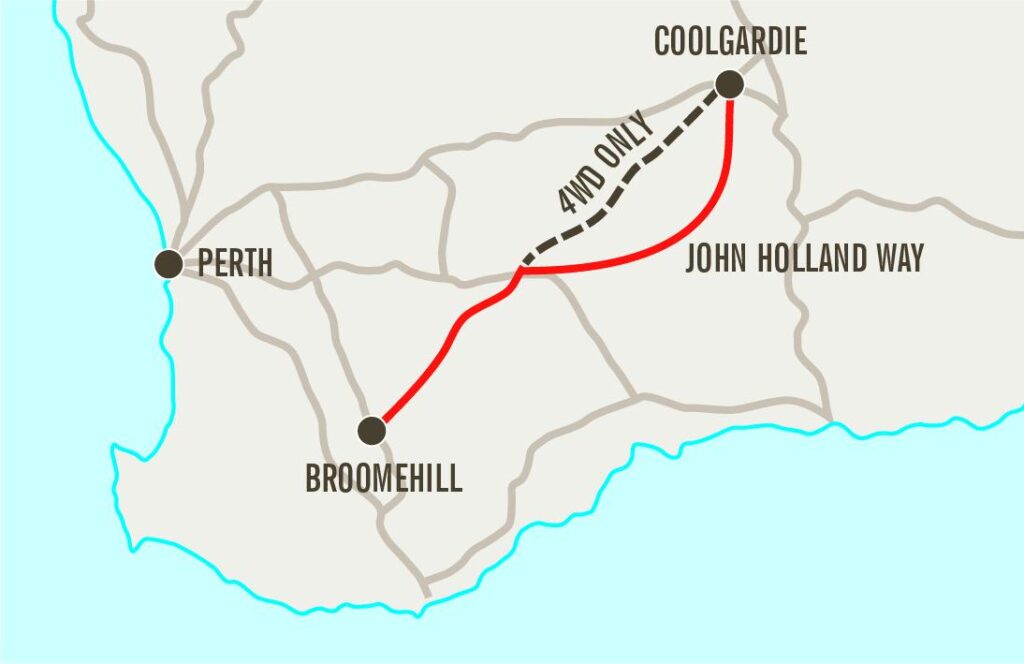Holland Track. Holland Track.
The gold find at Coolgardie by Bayley and Ford generated intense excitement throughout the country when it was made public in September 1892. As the news spread, the rush grew. Their discovery sparked a new gold rush to Western Australia. Eventually, Coolgardie had a population of 15,000 with another 10,000 living and working in the surrounding district. The streets of Albany were soon crowded with fortune seekers who came by ship from the Eastern States. Many of these “t’othersiders” travelled on the recently constructed Great Southern Railway to York and Northam where they purchased supplies and equipment before tackling the long trail east to the diggings.

John Holland
There were obvious advantages for a railway town further south in being the starting point for an overland trail. Not only would departing diggers spend their money there, local producers would have direct access to the fast-growing goldfields market.

William Ford
Several attempts to open up such a route failed. All were forced back by the waterless and seemingly impenetrable nature of the country. Then John Holland took up the challenge. Born in the colony, 37-year-old Holland was an experienced bushman. His idea was not to only find a feasible route, but to actually cut a track that could be used immediately by horse drawn conveyances. Joined by three older local men, Rudolph Krakouer, David Krakouer and John Carmody and five ponies they set off with 100 gallons of water on 26 April 1893 arriving in Coolgardie on 3 July 1893. They had completed the cutting of a cart track over 500km in length in just two months and four days, a remarkable achievement.
Holland would ride out more than a 25 km distance ahead of his crew cutting the track to find new areas with signs of water in rocky outcrops to keep the crew hydrated. The water would flow into the lower sections of the rocky outcrops and pool in rock holes, some of which have been covered by man to help prevent animals and dropping from falling causing water contamination. These holes are also known as ‘Gnamma holes’.
As anticipated, the track was immediately adopted by hundreds of eager diggers joining the rush. It was regularly used by horse and camel teams transporting goods and supplies to the goldfields. Travelling time between Broomehill and Coolgardie was usually about two weeks.
Despite Rudolph Krakouer being the main organiser and financier of the expedition, John Holland, who was also on the expedition, was later able to claim most of the credit, and the Track is named after him.
Holland and his crew where the first none indigenous people to travel through this bushland and cut their way through. The track was used by around 18,000 people over the next three years however it became redundant when the railway was eventually extended to Fly Flat in 1896.
As the expansion of the wheatbelt overtook the southern half of the track during the 1920’s, that part of the route played an important part in opening up a number of wheat-growing regions. Some of the track was incorporated in the growing rural road network. Low rainfall out beyond the Rabbit Proof Fence discouraged further settlement and the northern half of the Holland Track gradually returned to the wild. The historic route became overgrown and all but lost in a tangle of sand plain scrub and mallee thickets.
TRAVELLING THE HOLLAND TRACK TODAY


Embark on a real Australian outback adventure following a pioneering route created by John Holland through rugged bushland and woodlands. This very popular 4WD trail connects Broomehill in the southern Wheatbelt to Coolgardie in the Goldfields and can actually be undertaken in two sections with different driving conditions
The John Holland Way route connects Broomehill to Coolgardie mainly on bituminised and usually good surface gravel roads. The Holland Track (4WD only) also starts in Broomehill, but then from the Hyden / Norseman Road north it follows a different route that is a real adventurer 4WD track. Continue reading
Travelling the John Holland Track today
Return to BROOMEHILL PLACES Page
Return to BROOMEHILL Page
Return to HOME Page
